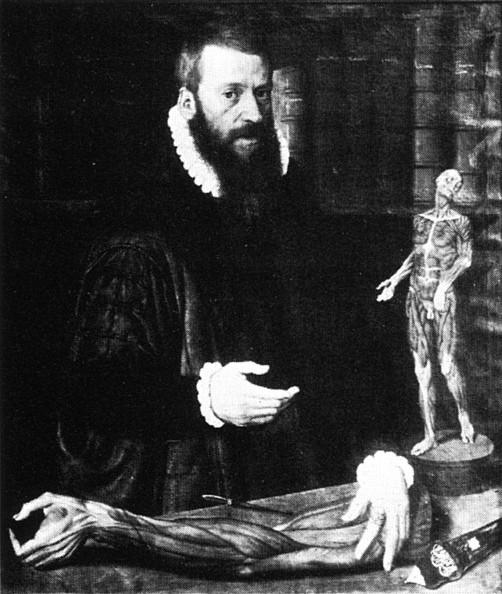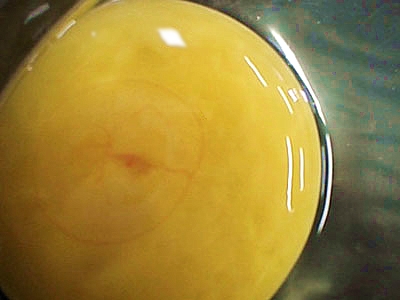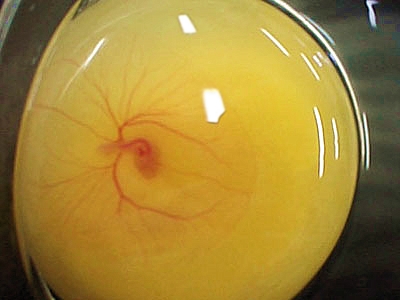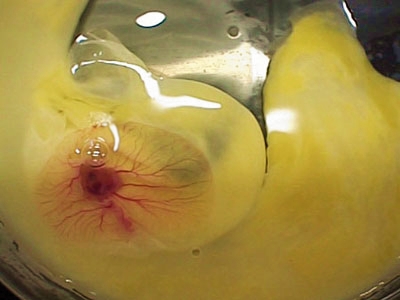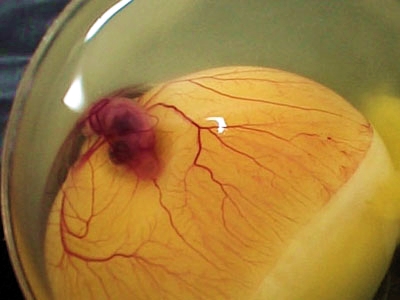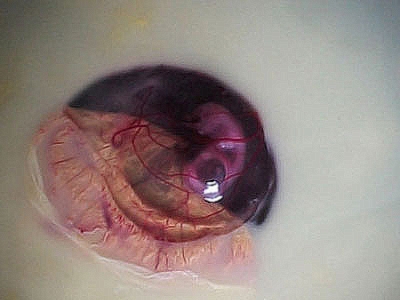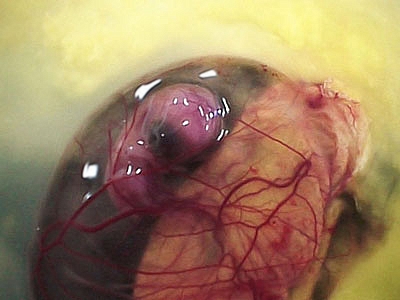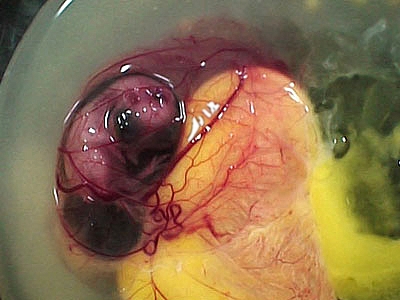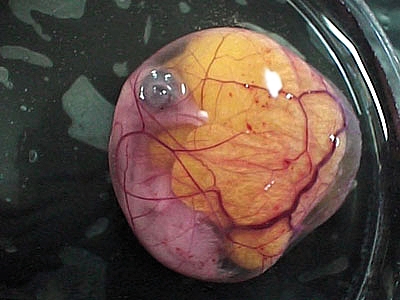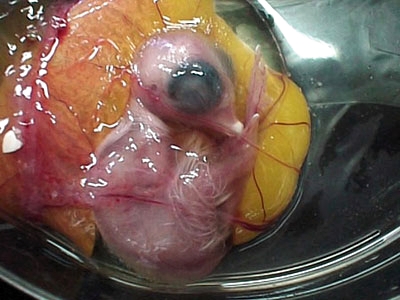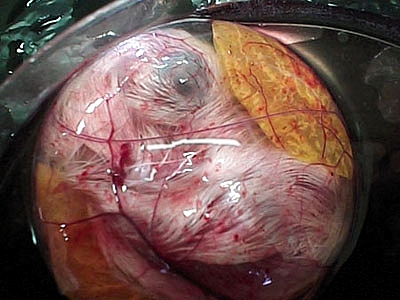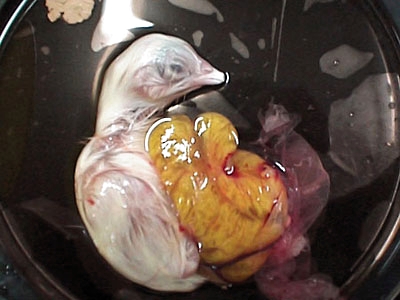Coiterchick
1564
The Chick of Volcher Coiter
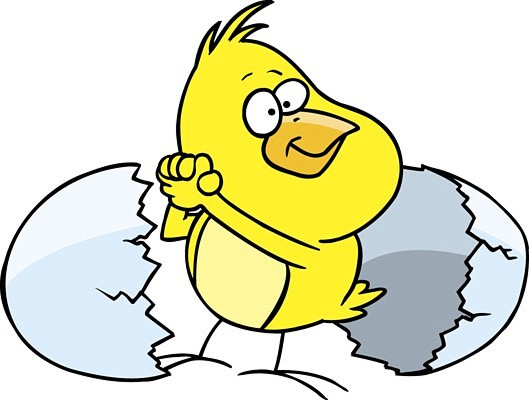
Transcribed
by Fernando Civardi ![]()
Translated by Elio Corti
Translation reviewed by Elly Vogelaar ![]()
The translation began on April 11 & ended on June 8 - 2010
Thanks to PRAVDA.Ru for embryo's photos
Praise
of William Harvey
to the embryology of Volcher Coiter
The
Latin text is drawn from
Guilielmi Harveii Opera omnia
A Collegio Medicorum Londinensi edita – mdcclxvi
Exercitatio
decimaquarta. - De
generatione foetus ex ovo gallinaceo.
14th exercise - The generation of the fetus from the egg of hen
|
[240] Aristoteles olim, nuperque Hieronymus Fabricius, de generatione et formatione pulli ex ovo, accurate adeo scripserunt, ut pauca admodum desiderari videantur. Ulysses Aldrovandus tamen ovi pullulationem ex suis observationibus descripserit; qua in re, ad Aristotelis auctoritatem potius, quam experientiam ipsam collimasse videtur. Quippe eodem tempore Volcherus Coiter Bononiae degens, eiusdem Ulyssis, praeceptoris sui, ut ait, hortatu, quotidie ova incubata aperuit, plurimaque vere elucidavit, secus quam Aldrovando factum est; quae tamen hunc latere non poterant. Aemilius Parisanus quoque, medicus Venetus, explosis aliorum opinionibus, novam pulli ex ovo procreationem commentus est. |
Once Aristotle, and recently Girolamo Fabrizi, wrote in a so accurate manner about the generation and the formation of the chick from the egg, that very few things would be regarded as necessary. Nevertheless Ulisse Aldrovandi would have described the generation of the chick from the egg according to his own observations; it seems that on this point he turned the glance to the authority of Aristotle rather than to a true experience. Really in the same period Volcher Coiter, who was dwelling in Bologna, on incitement of Ulisse himself, his own teacher, as he affirms, opened every day incubated eggs and truly he clarified a lot of things, otherwise Aldrovandi did, all things that to the latter would not be remained unknown. Also Emilio Parisano, physician in Venice, after having disapproved of the ideas of others, invented a new generation of the chick from the egg. |
Externarum et internarum principalium
humani corporis partium tabulae
autore Volchero Coiter Frisio Groeningensi
inclytae Reipublicae Noribergensis Medico Physico et Chirurgo
Norimbergae in officina Theodorici Gerlatzeni
MDLXXIII
|
[32 |
About the beginning and the progress of generation of the eggs of gallinaceans and the sequence of creation of gallinaceous chick. |
|
Postquam in fine tabularum de internis humani corporis partibus, quae ad brutorum generationem et foetuum partes peculiares pertinent, attigi, quo ex abundanti et nunc discrimen hac in parte inter quadrupeda et volatilia dignoscatur, et etiam quidam Philosophi, sese ex scrupolosis in scholis ubique agitatis quaestionibus atque ambiguitatibus omnibus facilius explicare queant: operae praetium esse duxi hic subtexere, quae in generatione, et formatione pullorum gallinaceorum animadverti. incipiam a prima ovorum generatione, descendam ad ovi absolutam perfectionem, et ultimo recensebo historice, quidnam singulis diebus, dum inter incubationem formantur et animantur pulli, novi procreetur. Ne lector, qui quid naturalium rerum scriptores qui sunt Hippoc: Aristoteles et Plinius de procreatione pullorum gallinaceorum, tradidere, legit, ullibi[1] offendatur, vel in veritatis exquisita cognitione assequenda remoretur, dissentiunt enim inter se autores: deinde ne quispiam vel historiae meae obscuritate, vel prolixitate, vel etiam ob sententiarum contrarietatem inter legendum implicetur haesitetque, placuit in fine brevibus huius materiei scriptorum sententias adiicere. |
After
at the end of the tables dealing with the
internal parts of the human body
I have dealt with matters concerning the generation of animals devoid
of reason and the parts characteristic of fetuses, I thought
it worthwhile to add here my observations during the generation and
formation of chicks of the fowl, so that in addition a full
distinction in this section may now be done between quadrupeds and
birds, and also in order that some philosophers may be able to free
themselves more easily from all rough problems and ambiguities
discussed everywhere in the schools. I shall start from the beginning
of the generation of the eggs, I shall proceed to the ultimate
perfection of the egg and finally I shall .examine in chronological order what new is created on each day while
the chicks are being formed and endowed with life during incubation.
In order that the reader, who has read what the naturalist writers,
who are Hippocrates |
|
Ova in plerisque avibus generationis primordium ab avibus faeminis sumere, Zephyria, sive hypenemia, id est subventanea, quae alias sterilia et irrita vocantur, et absque maris semine excusa sunt, demonstrant. circa brumam itaque in gallinis communibus sub diaphragmate, ubi cava vena ex iocinore prodiens, diaphragma perrumpit, sensim ac pedetentim, multi parvi et subflavi globuli ex mero vitello conflati, cumulatim ob ventris brevitatem acervantur, ac colliguntur, minime secundum ventris longitudinem, ut in viperis et serpentibus oviparis, monilis ex corallis sive magnis margaritis conflati instar, iuxta intestina utrinque extenduntur. Eo in loco fovendis ovis aptissimo, dorsi in primis, deinde circumpositarum partium ligamenta dilatata atque expansa, singulis ovis, singulas membranas venis arteriisque refertas, ut inde nutrimentum augmentumque acciperent, impartiunt. globuli in principio pauci et parvi numero et quantitate aucti, maiores et inferiores primo, post reliqui ad priorem uterum protruduntur, ex hoc ad secundum, a secundo perfecta prorumpunt: qua vero ratione, nunc per utriusque uteri explicationem declarabo. |
Zephyrian or full of wind eggs, that is, subventanea, which sometimes are called .sterile and fruitless and have been produced without the semen of the male, demonstrate that in most birds the eggs originate from female birds. Therefore during the winter time in the common hens, under the diaphragm where the vena cava arising from the liver overtakes the diaphragm, slowly and gradually many small yellowish globules, made up only of yolk, accumulate and gather because of the shortness of the abdomen, but not along the length of the belly as it happens in vipers and oviparous serpents where they are spread out everywhere beside the intestines like a necklace of coral or of large pearls. In that area, which is most suitable for nourishing the eggs, the enlarged and expanded ligaments firstly of the back, and then of the surrounding structures, give to each egg an its own membrane filled with veins and arteries so that it may receive nourishment and growth from them. The globules, in the beginning few in number and small, after have grown in number and size, first the larger and lower ones and then the rest, are thrust into the first uterus, from this into the second, from the second come out finished structures. In what manner, I shall now make clear by an explanation of both uteri. |
|
In gallinis duo reperiuntur uteri, quorum alter elatior existit, et lati intestinuli in gyros circumvoluti formam representat, albo colore praeditus, vacuus, et dorso annexus a me inventus est. Superiori regione pertingebat ad imperfectorum ovorum cumulum, sub diaphragmate a dorsi ligamento dependentem, cui beneficio tenuissimae membranae alligatus erat. hic deprehendere non potui foramen, per quod inchoata ova vel ovorum seminaria, in hunc ingrediantur uterum. Constat autem primus uterus ex duabus tunicis interna nimirum, et externa, interna est alba, multis rugis referta, sic enim ante iustum tempus ova non elabuntur, externa similis est peritonaeo, quae a vena cava ramos venarum satis insignes, ab aorta arterias multas ad uterum ducit. in hoc ova valde augentur et albumen consequuntur. |
In the hens two uteri are found, one of these is situated higher up and in shape is similar to a widened small intestine wounding in loops, which I have found to be endowed with white color, empty, and attached to the back. Superiorly it was extending until the heap of imperfect eggs which is suspended under the diaphragm from a ligament of the back to which the uterus is joined thanks to a very thin membrane. I was unable to find a foramen here through which the rough eggs, that is, the little seeds of the eggs might enter this uterus. Moreover the first uterus consists of two tunics, that is, internal and external. The internal tunic is white and endowed with many folds, and hence the eggs do not escape before the proper time. The external tunic which conducts to the uterus rather large branches of veins from the vena cava and many arteries from the aorta, is similar to the peritoneum. In this uterus the eggs enlarge greatly and acquire albumen. |
|
Alter
et inferior uterus, per quem galli semen immittitur, longitudine
adaequat dimidium digitum, consequitur orificium angustum et strictum,
quod ad crassitiem ovi perfecti dilatatur, uterus vero hic laxe ovum
comprehendit. Substantia eius est crassa atque ex propria impropriaque,
sive a peritonaeo mutuata, conflatur tunica. externa haec peritonaei,
tenuis atque plurimis venis arteriisque conspicuis intertexta est.
Interna sive propria crassior est, multo et minoribus paucioribusque
vasis perfusa. Uterus hic secundus terminatur ad glandulas duas, quae
renum in avibus vicem subire existimantur, isthic habet strictum
orificium sphincteris instar, quod a secundo utero excipitur, haud
dubie {sphinctir} <sphincter> hic dilatatur et constringitur
rursus, dum ovum ingreditur, [33 |
The
other uterus, the lower, through which the semen of the cock is
introduced, is half a finger long, it has a small and narrow orifice,
which widens out until to the size of the perfect egg. But this uterus
holds the egg easily. Its structure is thick and is composed by an its
own tunic and another tunic which is not its own since is derived from
the peritoneum. The external peritoneal tunic is thin and interwoven
by very numerous veins and by conspicuous arteries. The internal or
proper tunic is thicker and perfused by much smaller and much fewer
vessels. This second uterus terminates near two glands which are
thought to perform the function of kidneys in birds. In this place it
has a tight orifice like a sphincter which belongs to the second
uterus, and no doubt that this sphincter widens out and newly narrows
when the egg is entering and when the egg has entered.
The function of this second uterus is to dry the egg and so
much harden it by its heat that it may acquire the shell. To say the
truth, whether the prolific semen of the cock is here imparted to the
egg, I do not know. The cervix of the uterus is rather long and thick.
Thus far about the origin and completion of the eggs. Now I shall
consider the growth of the chick or development of the fetus. It
should be observed here that gallinaceous chicks just as those of
other birds are formed more slowly or more rapidly in accordance with
their own nature, the season, the region, the constancy of incubation.
Columella |
|
Equidem anno 1564. mense Mayo Bononiae, instigante me Philosophiae ordinariae professore excellentissimo, viro ut variarum scientiarum artiumque sic Philosophiae, et in primis vero naturalis partis scientia eximio, Doctore Ulysse Aldruando, promotore et praeceptore meo perpetua observantia colendo, et aliis doctoribus studiosisque cohortantibus, mandavi duas Gallinas glocientes, sive ad incubationem proclives seligi, earumque singulis 23. ova subiici: atque istis comitantibus, singulis diebus unum, quo haec duo praecipue cerneremus, nimirum originem venarum, atque quid primo in animali gignebatur, aperui. |
As
for myself, in May 1564 at Bologna, stimulated by Doctor Ulisse
Aldrovandi |
|
In primi diei ovo vidi luteum consequutum circulum album, non admodum magnum, in cuius medio eiusdem coloris punctum sive orbiculum, ex circulo fluebant duo germini[2], quorum alter crassior et longior altero existebat, vitellus fluidior, atque recentis ovi luteum. |
In the egg of the first day I saw that the yolk had acquired a white circle which was not very thick, in whose center there was a point or small disc of the same color. From the circle two prolongations flowed away, one of them was thicker and longer than the other. The yolk was more fluid than the yolk of a fresh egg. |
|
Secundo
die
|
|
|
Secundo die vidi duas tenuissimas pelliculas, ceu membranas, quarum altera putamini immediate adhaesit, altera aliquantisper a putamine dissita substantiam ovi involvebat, in cacumine enim spatium exiguum fuit vacuum. Vitellus elatus erat ad cacumen, ut Aristoteles inquit tertio die fieri. Vitelli media pars candidior reliqua parte cernebatur. in medio conspexi quid semini simile. punctus et circulus inventi sunt, sub membrana involvente ovi substantiam, atque fibris quibusdam sanguineis aspersi. album ut vitellus aliquanto liquidior solito. substantia alba vitro similis, quam vulgus semen galli existimat, aliquanto durior extitit. |
On the second day I saw two very thin pellicles or membranes, one of which adhered immediately to the shell, the other, which surrounded the substance of the egg, was separated a little from the shell. For a small empty space was present at the pointed end of the egg. The yolk had moved toward the pointed end of the egg as Aristotle says to happen on the third day. The middle part of the yolk was seen to be clearer than the remaining portion. In the center I saw something resembling a seed. The point and the small disc were found under the membrane surrounding the substance of the egg and bestrewn with certain sanguineous filaments. The white, like the yolk, was a little more fluid than usual. The white glass-like substance, which is commonly held to be the semen of the cock, was a little harder. |
|
Tertio
die
|
|
|
Tertio die in albumine nulla fuit deprehensa mutatio, at punctus, sive globulus sanguineus in vitello ante inventus, iam in albumine potius repertus, manifeste pulsabat, fundebatque unum venae ramum, ut ex colore iudicare quivimus, qui in duos scissus, multos emisit ramusculos, qui circuli modo pulsantem punctum ambiere. hi ramusculi suffulciebantur membrana tenuissima, quae tum munere, tum substantia secundinam exprimebat. Tres itaque hic repertae sunt membranae, quarum prima putamini {asscribitur} <ascribitur>, secunda ovi universae substantiae, tertia secundinae. |
No change in the albumen was detected on the third day, but the sanguineous point or globule previously found in the yolk, but now found rather in the albumen, manifestly pulsated and, as we were able to judge by the color, gave rise to one venous trunk which, after dividing into two, gave off many small branches which encircled the pulsating point. These small branches were supported by a very thin membrane which represented the secundine - allantoid - both in function and structure. Hence three membranes were found at this time, the first is assigned to the shell, the second to the whole substance of the egg, the third to the secundine. |
|
Quarto
die
|
|
|
Quarto die pertudi ovum ab obtusiori parte, et primo occurrit spatium adeo vacuum, ut articulum digiti priorem facile admiserit. album instar aquae, ob tenuitatem diffluebat, globulus et reliqua maiora reperta sunt, pulsabat autem globulus, vasa minime. ab altero latere globuli tres sibi mutuo coniuncti, colore translucidi, vitro simili reperti. ab altero duo rami, sive vasa arteriis non dissimilia extitere, quae tamen non pulsabant. Albumine effuso in conspectum prodiit vitellus satis liquidus, et hinc inde sanguine quoquo modo conspersus. |
On the fourth day I opened the egg from the blunter end and there occurred first a space so empty that it easily admitted the distal phalanx of a finger. The white, seeming water, flowed off on account of its poor consistence, the sanguineous globule and the other structures were found to be larger. Moreover the globule pulsated, the vessels very little. On the opposite side, three translucid glass-like globules were found joined together. On the other side there were two branches or vessels, not unlike arteries, which, however, did not pulsate. After the albumen poured off, a rather liquid yolk came into view, besprinkled here and there with blood in a not uniform manner. |
|
Quinto die deprehendimus secundam membranam totius ovi substantiam ambientem, et multis venis perfusam, ita a putaminis membrana liberam et validam, ut absque offensione cum ovi substantia extrahi potuerit. aperta hac membrana, globulum sanguineum pulsantemque vidi profundius solito subsidisse. sumpsi utriusque gallinae quinti diei ovum, et in altero apparuit tantum globulus pulsans adhuc informis, sanguine utcunque circumfusus cum suis venis, ut ante dictum est. globuli a latere existentes colore tendebant ad nigrum habebantque in medio minores adhuc globulos, qui coniuncti cerebrum quoquo modo {representarunt} <repraesentarunt>, tertius globulus, non nisi in magnitudine mutatus fuit. In albumine visae sunt partes dissimilares, quarum quaedam tenues ad candorem accedentes, quaedam crassiores. Vitellus facillime cum albumine confundebatur. In altero ovo manifeste caput pulli apparuit pro ratione corporis maximum, et in eo utrinque a lateribus unus oculus subniger, qui in medio perlucidus conspiciebatur, in medio oculorum tertius globulus, a capite dependebat reliquum corpus oblongum, non longe a capite cor vel orbiculus pulsans situs, unde et venae visae sunt primam ducere originem. nullum hic potui deprehendere hepatis vestigium, ita interna erant confusa. |
On the fifth day we observed that the second membrane was surrounding the substance of the whole egg and was invaded by many veins, so free from the shell-membrane and so strong that, without injury, it could be removed together with the substance of the egg. When this membrane was opened, I saw that the sanguineous, pulsating globule had sunk more deeply than usual. I took an egg of the fifth day from both hens and also in the other one only appeared the pulsating still formless globule which was, however, surrounded by blood with its veins, as previously told. The globules present in the other side tended to be black in color and between them they had still smaller globules which, interconnected, after a fashion imitated a brain. The third globule was different only in size. In the albumen dissimilar parts were seen, some of them were thin verging to snow-white, others were denser. The yolk was easily mixing with the albumen. In the other egg the head of the chick clearly appeared very large with respect to the size of the body and on both sides of the head there was a blackish eye, which was found to be very clear in the middle. Between the eyes there was a third globule. The rest of the rather long body hung down from the head. Not far from the head was situated the heart or a pulsating disc from which also the veins were seen to arise. I was able to find no trace of the liver, so confused were the viscera. |
|
Sexto
die
|
|
|
Sexto
die praeter reliqua, quae omnia fuere maiora, vidimus ab obtusiore
parte post[3]
membranarum sive pellicularum primo albumen, haerebat enim luteum in
fundo, in albumine pullus vivus animatus, et omnibus suis partibus
adumbratus fluctuabat, caput pro ratione [34 |
On
the sixth day, in addition to the other parts which were all larger,
from the blunter end we first saw the albumen beyond the membranes or
pellicles, for the yolk was sticking to the bottom of the egg. The
alive and kicking chick, and sketched in all its parts, floated in the
albumen, it had a very large head in proportion to the body, it had
nothing more perfect or larger but the eyes. For, but with some
difficulty, I was able to distinguish in the eyes all the tunics and
humors from one another. Hence from the fact that in birds the eyes
are developed first, Firmianus Lactantius |
|
Septimo
die
|
|
|
Septimo die omnia manifestius sese visui obtulere, primo pelliculae tres, praesertim tertia secundina dicta, venas suffulciens, et omnem liquorem circundans. emisso liquore candido cum flavo, animal exiguum et rudi minerva efformatum prodiit. caput illi erat caeteris corporis partibus tum maius, tum perfectius, dignoscebatur et craneum et rostrum exquisitius, reliquum corpus cum membris informatum. ex visceribus nullum quasi potui distinguere, tum quia ventri thoracique inclusa erant, tum quia intus necdum veram et manifestam delineationem consequuta erant, undique enim confusa cernebantur. |
On the seventh day everything could be seen more clearly, first the three pellicles, especially the third called secundine which supports the veins and surrounds all the fluid. After the white fluid along with yellow had been poured off, a small, rudely-formed animal appeared. Its head was larger and more perfect than the other parts of the body. Both the cranium and the beak were observed to be more improved. The rest of the body and limbs were formless. I was able to distinguish almost none of the viscera both because they were held in belly and thorax, and because internally they had not yet attained a true and manifest form, for they were seen confusedly everywhere. |
|
Octavo
die
|
|
|
Octavo die inveni omnes partes maiores magisque delineatas, et crura et alas, ita, ut iam pulli effigiem demonstrarit. validiori motu in ovi albumine se ipsum volvebat. Praeter haec reperi venas satis conspicuas, in pulli umbilicum immissas. |
On the eighth day I found that all parts, including legs and wings, were larger and better formed, so to already exhibit the likeness of a chick. It moved around in the albumen with more vigorous motion. In addition I found rather conspicuous veins entering the umbilicus of the chick. |
|
Nono vidi secundinam venarum tum multitudine, tum magnitudine auctam, denique et copia sanguinis solito turgidiorem, transudaverat etiam sanguinis tenuissimi nonnihil, post secundinam visui occurrit pullus fluitans in albo et utrinque a lateribus vitelli dimidium, tanque vitellus in duas aequales partes dissectus fuisset, vasa umbilicalia multo erant maiora. Pullo exempto detraxi membranam propriam immediate pullum cingentem, ne scilicet in humore periret. Iam omnibus partibus absolutus et poris latis, ex quibus pennarum primae radices prorupturae erant, undequaque conspiciebatur. caput omnium maximum extitit, oculi vero perfectissimi et suis palpebris donati. In capite vidi tres globulos transparentes, et simul avium cerebrorum figurae efformantes. Inferiores omnes a collo partes, ad integram naturalemque figuram perductae. foris in pectore e cordis regione pulsatio apparuit, cor suam habebat formam et colore subalbido praeditum, pulsabat etiam extra pullum diu. iecur subpallidum, ventriculus, intestina, costae et omnia alia viscera admodum fluida atque flaccida reperiebantur. albuminis duplex substantia, et singulae singulis propriis membranis compraehensae erant. Altera portio fuit translucida et pullum ei innatantem continebat. altera lenta, crassa et pallida tanquam excrementitia albuminis portio in fundo ovi haesit. |
On the ninth day I observed that the secundine had increased with respect to the number and size of its veins. Furthermore, it was more turgid than usual because of abundance of blood, and some very diluted blood had also transuded. After the secundine, the chick was visible floating in the white with half of the yolk on each side as if the yolk had been cut into two equal parts. The umbilical vessels were much larger. After the chick had been taken out, I removed the proper membrane immediately surrounding the chick so that it might not perish in the liquid. The chick was now observed perfect in all parts everywhere with large pores, from which the primordia of feathers were about to emerge. The head was the largest of all parts, besides the eyes were perfect at all and provided with their lids. I saw three transparent globules in the head, the combination of them producing the form of the avian brain. All parts below the neck had attained their complete and natural form. A pulsation appeared externally in the chest due to where the heart is located. The heart had attained its form and was whitish in color. Moreover it was beating for a long time even if outside the chick. The rather pale liver, the stomach, the intestines, the ribs and all the other viscera were found to be very flabby and flaccid. The substance of the albumen was double and each was surrounded by its own specific membrane. One portion was transparent and contained the chick floating in it, the other was viscous, dense and pale, and was adhering at the bottom of the egg as it were the excrementitious portion of the albumen. |
|
Decimi
diei ovum
|
|
|
Decimi diei ovum habebat secundinam solito aliquanto robustiorem, venas sanguine foris irroratas. Foetus vitello tanque pulvinari instratus omnibus partibus absolutus: femora dorsum et clunes erant primis radicibus pennarum obductae. corpus vel venter pulli capite aliquando maior, contrarium asserit Aristoteles. In oculis omnes tunicas, omnes humores, et externa velamenta utpote palpebras, atque membranam qua nictitant, vidi. cerebrum suos habebat anfractus et gyros, cor vero naturali figura et colore candido, ut partes spermaticae, praeditum: pulmo ac costae erant efformatae. in ventre inferiori iecur ab albo colore ad rubicundum tendebat, ventriculus atque intestina candidissima. prodibant ex foetus ventre iuxta anum duo vasa umbilicalia ad vitellum tendentia. exempto pullo deprehendimus maiorem partem albuminis absumptam, et quod super erat, crassum excrementum extitisse, a vitello vero parum vel nihil abscessisse. |
The egg of the tenth day had a secundine somewhat stronger than usual and veins on the outside with flowing blood. The fetus, laying upon the yolk as on a cushion, was perfect in all its parts. The legs, the back and the buttocks were covered with the primordia of feathers. The body or belly of the chick was now larger than the head. Aristotle states the contrary. In the eyes I saw all the membranes, all the humors, and the external covers or lids, as well as the membrane with which they wink. The brain had its sulci and convolutions. The heart, indeed, had its normal form and was white in color like the reproductive parts. The lung and the ribs were formed. In the lower part of the belly the liver tended from white to reddish in color, the stomach and the intestines were very white. Two umbilical vessels emerged from the belly of the fetus next the anus and proceeded to the yolk. When the chick had been removed, we noticed that the greater part of the albumen had been used up and what remained was a dense excrement. Little or nothing from the yolk, however, had disappeared. |
|
Undecimo die nullam, nisi quae in magnitudine est, cognovimus differentiam, manifestius atque caput, creverat, pennae subpullularant. foetus in albo et tenui liquore, vitello incumbens, natabat. sub vitello haesit crassum et viscidum albumen. |
On the eleventh day we found no difference except in size. Also the head had grown more evident and the feathers had sprouted a little. The fetus, lying upon the yolk, floated in the white and tenuous fluid. The dense and viscid albumen adhered below the yolk. |
|
Duodecimo
die
|
|
|
Duodecimo
die, praeter caetera consideravimus membranas et humores, membranae
fuerunt quatuor, quarum prima roboris gratia putamini concessa est,
ita enim valide putamen fragilissimum unitum conservat, ut ovum recens,
et crudum ne a robustissimo viro, si acutiores partes utraque manu
comprimantur, quidem rumpi queat. secunda totam ovi substantiam ambit
deprimitur et constringitur, pro ovi imminutione, et contractione et
hac ratione inhibet partium ovi, quae facile commotione, cum omnia
liquidiora incubationis tempore redduntur, fieri potuit, confusionem.
Tertia praebet venis arteriis sustentaculum atque stabilimentum,
arteriis enim atque venis est referta, extrinsecus sanguine subtili
conspersa totum ovum circundat, et secundinae munere fungitur. [35 |
On the twelfth day, in addition to other things, we examined membranes and humors. The membranes were four. The first was fused with the shell thanks to its strength, for so strongly it holds the very fragile shell together that a fresh and raw egg cannot be broken if the pointed ends are compressed by both hands, except that by a very strong man. The second membrane surrounds the entire substance of the egg. It is depressed and contracted according to the diminution and contraction of the egg. In this way it prevents the mingling of the parts of the egg which could easily occur because of shaking, since everything becomes more liquid during incubation. The third membrane affords a support and a sustain for veins and arteries, for it is full of arteries and veins. Moistened externally by tenuous blood, it surrounds the whole egg and performs the function of the secundine. The third membrane is followed by the membrane proper to the chick, which contains not a little water in addition to the chick. It seemed to me that this tunic or membrane is dilated next to umbilicus and that it wraps the umbilical vessels. As for the chick, it was larger and more solid and was covered with larger feathers. Something white loosely adhered at the end of the upper and lower bill. Women say that this prevents the picking of grain and for this reason they remove this white formation as soon as the chicks hatched. |
|
Decimo
tertio die
|
|
|
Decimo tertio vidimus substantiae ovi minorem quantitatem, pullum maiorem atque magis pennatum: nihil praeter haec peculiare. |
On the thirteenth day we saw that the substance of the egg was diminished in quantity. The chick was larger and more feathered. Besides these things there was nothing special. |
|
Decimo quarto die, quantum ovi albumini abscesserat, tantum pullo augmenti accessit. erat etiam totus parvis pennis contectus. liquor pellucidus, crassus et viscosus, minori quantitate solito, propria membrana, ut et vitellus pellicula vasis referta, continebatur. Umbilici vasa visa sunt mihi numero quinque esse, quorum una vena membranam tertiam sive secundinam, cui multos ramos impartiebatur, petebat: duae vero aliae venae per tunicam vitellum investientem disseminabantur. praeter has venas, repperi inter vasa umbilicalia duas arteriolas, anfractuose vermium instar, ad vitellum tendentes, insertionem animadvertere non potui. |
On the fourteenth day the chick had a growth equal to the amount of albumen that had disappeared. It was also entirely covered with small feathers. The transparent, dense and viscous fluid, smaller in quantity than usual, was contained in its own membrane just as the yolk was contained in a pellicle full of vessels. The umbilical vessels seemed to me to be five in number. One vein ran to the third membrane or secundine to which it supplied many branches, but two other veins were distributed throughout the tunic covering the yolk. In addition to these veins, I found among the umbilical vessels two small arteries which, coiled like worms, were going towards the yolk. I was unable to observe their attachment. |
|
Decimo
quinto die
|
|
|
Decimo quinto die vasa undique per secundinam diffusa fuere, et adeo tenues habebant tunicas, ut levi cultelli contactu vulnerabantur, effluxit sanguis valde rubicundus et tenuis. haec vasa sive venae, ab uno ramo satis crasso per medium chorii longe extenso prodiere. dissecta secundina, effluxit aquosi seri non parum. deinde vesicula sive membrana in conspectum venit, in qua haerebat foetus in aqua natans, et simul vitellus propria membrana conclusus. haec membrana secundinae, ut in foetu humano amnios chorio, annexa erat. vitellus in duas partes manifeste divisus, cohaerebat vix spatio dimidii digiti latitudinis, una tamen utrique parti fuit membrana, quae ex umbilico sive cute pulli enata fuit. reliqua superioribus respondebant. |
On the fifteenth day the vessels were scattered everywhere through the secundine. They had tunics so thin that they were injured by slight contact with the knife. Very red, thin blood flowed out. These vessels or veins proceeded from one rather thick trunk, which extended for a long distance through the middle of the chorion. When the secundine was cut, no little watery serum flowed out. Then came into view the vesicle or membrane to which adhered the fetus floating in water, and at the same time the yolk covered by its own membrane. This membrane was fused to the secundine just as in the human fetus the amnion is fused to the chorion. The vitellus was clearly divided into two parts and cohered only for half a finger's breadth, but for both parts there was one membrane which arose from the umbilicus or skin of the chick. The rest corresponded to what before has been described. |
|
Decimo
sexto die
|
|
|
Decimo sexto vidi crassam viscosamque albuminis partem undequaque fere absumptam, et arteriae pulsantis ramum dissipatam {iter} <inter> membranam vitellum cingentem. membrana pulli et lutei eadem erat. alia quae augeri debuere, maiora, quae imminui oportuit minora sunt visa: inter caetera venter multo erat solito tumidior et crassior: in ventre viscera plurimum incrementi sumpserant. In ventriculo repperi substantiam chylosam, cuius tamen maior portio fuit in fine stomachi, iuxta ventriculum. extra ventrem pendebant vasa duo vermium instar, quae potius intestinis, quam arteriis assimilabantur. |
On the sixteenth day I saw that the dense and viscous portion of the albumen had been used up almost everywhere and that the branch of the pulsating artery distributed it throughout the membrane surrounding the yolk. The membrane of the chick and of the yolk were the same as formerly. Other things which should have grown were observed to be larger; those which should have diminished in size were seen to be smaller. Among other things, the belly was much more swollen and bigger than usual. Within the belly, the viscera had grown very much. In the stomach I found a chyle-like substance, the major portion of which, however, was in the end of the esophagus next to the stomach. Two worm-like vessels, which resembled intestines rather than arteries, hung down outside the belly. |
|
Decimo
septimo die
|
|
|
Decimo septimo die vidi et inter tertiam et quartam, et inter quartam et pullum substantiam aquosam, sed paucam, deinde ex umbilico vidi prodire arteriam unam, tres venas, et apophysim ab intestinis ad vitellum. venarum duae ingrediebantur venas mezeraicas, tertia ad cavam, arteria magna trascendens ventriculum, inserebatur in cor, ut alias vidi. Intestina extra umbilicum aliquo usque propendere, et meatus ex intestinis ad ovi vitellum pervenire vidi. faeces durissimae, nimirum putaminis instar, inter membranam quartam, et pullum deprehendebantur. in ventriculo repertum est chyli non parum cum aqua permixtum: vitelli non parum in ventrem attractum fuit. positus, situs descriptioni Aristotelis respondebat. |
On the seventeenth day I saw an aqueous substance, but scanty in amount, both between the third and fourth membrane and between the fourth and the chick. And then I saw emerge from the umbilicus one artery, three veins and an outgrowth going from the intestines towards the yolk. Two of the veins entered the mesenteric veins, the third the vena cava. A large artery, passing the stomach, entered the heart, as I saw other times. I saw the intestines jutting a little out of the umbilicus and some openings from the intestines reaching the yolk of the egg. Very hard shell-like feces were observed between the fourth membrane and the chick. In the stomach some chyle mixed with water was found. No little yolk had been drawn into the belly. Disposition and location corresponded to the description of Aristotle. |
|
Decimo
octavo die
|
|
|
Decimo octavo deprehendi inter membranam quartam et pullum, quid excrementi veri ex pullo. quarta membrana involvebat luteum et pullum. pullus fuit totus plumosus et ventricosus. Separata pulli membrana, repperi propriam vitelli membranam multis venis refertam, atque media ex parte cum vitello iam in longum exproducto, in ventrem raptam. viscosum, et album, cuius mentio est facta, omnino absumptum fuit. In pullo ventriculus, qui admodum creverat, continuit et parum serosi humoris et plurimum materiei candidae casei instar, quod credidimus chylum esse: tale etiam quid ex intestinis effluxit. |
On the eighteenth day I noticed some true excrement from the chick between the fourth membrane and the chick. The fourth membrane surrounded the yolk and the chick. The chick was completely feathered and endowed with belly. When the membrane belonging to the chick was separated, I found that the membrane proper to the yolk was filled with many veins and that in its middle portion it had been pulled into the belly together with the yolk, now drawn out in length. The viscous and white substance which has been mentioned was entirely used up. Within the chick, the stomach, which had grown very much, contained both a little serous fluid and a great deal of a white, cheesy substance which we thought was chyle. Some such substance, indeed, flowed from the intestines. |
|
Undevigesimo die pullus habuit caput deorsum inclinatum sub dextra ala et dextro crure reconditum. aquosus humor erat imminutus ubique, verae faeces inveniebantur inter tunicam quartam et pullum, sic et aquosus humor, quo pullus totus madebat. vitelli membrana conspicue visa est a cute pulli pronasci, atque ex contractione huius membranae vitellum intus rapi, atque absorberi, ut etiam fere absorptus erat. praeter hanc impropriam membranam, obtinuit et propriam multis venis et arteriis refertam. in ventre vidimus ea, quae ante, sed perfectiora, nihil vitelli (ut Albertus magnus vult) in intestinis deprehendi. habebat iam testes, cristam, gallus enim erat, praeterea audivimus pipientem. |
On
the nineteenth day the head of the chick was bent down and concealed
under the right wing and leg. The aqueous fluid had diminished
everywhere. Between the fourth tunic and the chick there were
encountered true feces as well as a watery fluid with which the whole
chick was wet. The membrane of the yolk was clearly seen to arise from
the skin of the chick. The yolk was seen, by the contraction of this
membrane, to be drawn inside and absorbed; indeed it had now been
almost wholly absorbed. In addition to this improper membrane, the
yolk had also a proper one filled with many veins and arteries. We saw
in the belly the things which we had seen before but they were more
perfect. I found no yolk in the intestines (as Albertus Magnus |
|
Vigesimo
die fuit pullus effectus, et in putamine quatuor reperiebantur
membranae sive tunicae, in una parte sibi mutuo annexae, quarum duae
interiores, multas venas et arterias continebant. [36 |
On the twentieth day the chick was fully formed and in the shell were found four membranes or tunics attached to one another at one side. The inner two of these membranes contained many veins and arteries. As for the chick, we saw three umbilical vessels inside. Two of these seemed to be arteries, one a vein. The umbilical opening was closed, but it could easily be opened when a probe was introduced. When the opening was dilated with a knife, the yolk emerged, invested with its own tunic and drawn out in length. The amount of yolk was a little lower and soon became visible. It was joined to the intestines by means of a canal prolonged from the intestines. The umbilical artery, which was mentioned in the egg of the seventeenth day, was observed to pulsate much more clearly than before, and to enter the heart. Two veins joined branches of the portal vein far from the liver. From the stomach, when cut open, flowed out chyle which was yellower than usual, with a little water. Water flowed from the crop and greenish feces from the rectum. The color of the liver tended to be yellow rather than reddish. The lung was reddish. |
|
Hippocratis sententia. |
Thought
of Hippocrates |
|
Hippoc: in libro de natura pueri[4] sic tradit, volucris ex ovi luteo nascitur hoc modo. Incubante matre ovum calescit, et quod in ovo inest a matre movetur, calescens autem id, quod in ovo inest, spiritum habet, et alterum frigidum ab aere per ovum attrahit. ovum enim adeo rarum est, ut spiritum, qui attrahitur, sufficientem ei, quod intus est, transmittat: et augescit volucris in ovo, et coarticulatur modo eodem ac consimili, velut puer, quemadmodum iam antea a me relatum est. Nascitur autem ex luteo ovi volucris, alimentum vero et augmentum habet ex albo, quod in ovo est. atque hoc iam omnibus manifestum factum est, qui animum adverterunt. Ubi autem deficit alimentum pullo ex ovo, non habens id sufficiens, unde vivat, fortiter movetur in ovo uberius alimentum quaerens, et pelliculae circum dirumpuntur, et ubi mater sentit pullum vehementer motum, putamen excalpens ipsum excludit. atque haec fieri solent in viginti diebus, et manifestum est, quod ita se habent. Ubi enim excusa est volucris, nullus humor in ovi testis inest, qui sane memorabilis existat, expensus enim est in pullum. Itidem Hippo: eodem in loco paulo ante sic inquit. Si quis ova viginti, aut plura, quo pulli ex ipsis excludantur gallinis duabus, vel pluribus subiicere velit, et singulis diebus a secunda exordiendo, usque ad ultimam, qua excudetur pullus ex ovo, subtrahere, ac videre, inveniet omnia se habere iuxta meum sermonem, quomodo volucris naturam ad humanam conferre oportet. Quod enim pelliculae ex umbilico tentae sunt, et reliqua, quae de puero dicta sunt, sic se habere in ovo volucris reperies, ab initio in finem. atque si quis nondum vidit, mirabitur in volucris ovo umbilicum inesse. atque haec sic habent, et sic a me relata sunt. |
Hippocrates in the treatise De natura pueri says as follows. A bird is born from the yellow of the egg in this way. When the mother is brooding, the egg gets warm, and that which is in the egg is moved by the mother. While the contents of the egg are getting warm, they have a breathing, and through the egg they attract other cold air from atmosphere. For the egg is so porous that it can transmit the air which is attracted in sufficient quantity for what is inside: and the bird grows in the egg, and it moves its joints exactly and quite likewise as a child does, in the same way as previously already has been reported by me. Furthermore the bird is born from the yellow of the egg, but it has its nourishment and growth from the white, which is inside the egg. And this appeared clear to all who paid attention. But when the chick lacks the nourishment from egg, and it does not have enough to live by it, perhaps it stirs inside the egg as seeking for more abundant food, and the membranes around it are broken, and when the mother notices that the chick is moving violently, she hatches it by pecking at the shell. And usually all this happens within twenty days, and it is well-known that this is the case. For when the bird is hatched, in the eggshells there is no noteworthy liquid, for it has been used for the chick. Likewise Hippocrates in the same treatise a little bit before says as follows. If someone would place underneath two or more hens twenty or more eggs so that chicks are born, and every day starting from the second up to the last he would remove and observe how a chick is hatching from the egg, he will find that all the things happen according to what I said about how the nature of a bird must be approached to that of humans. In fact you will find that the membranes depart from the navel and the remaining things said about the child appear in the same manner in the egg of a bird, from the beginning to the end. And if someone has not yet seen them, he will be marveled by the fact that in the egg of bird the navel is present. And the things are so, and they have been reported by me in this way. |
|
Plinii sententia. |
Thought
of Pliny |
|
Plinius lib: decimo capite 53. de tempore et generatione incubatus avium his verbis scribit. A coitu decem diebus ova maturescunt in utero. vexatae autem gallinae et columbae penna evulsa, aliave simili iniuria, diutius. Omnibus ovis medio vitelli parva inest velut sanguinea guttula, quod esse cor avium existimant, primum in omni corpore id gigni opinantes. In ovo certa est gutta, ea salit palpitatque. ipsum animal ex albo liquore ovi corporatur. cibus eius in luteo est. omnibus intus caput maius toto corpore. Oculi compressi capite maiores. Increscente pullo, candor in medium vertitur, luteum circumfunditur. Vicesimo die, si moveatur ovum, iam viventis intra putamen vox auditur. Ab eodem tempore plumescit, ita positus, ut caput supra dextrum pedem habeat, dexteram vero alam supra caput. Vitellus paulatim deficit. Aves omnes in pedes nascuntur, contra quam reliqua animalia. |
Pliny in the 10th book chapter 53 writes with these words about the time and the generation due to the incubation of birds. After mating the eggs become ripe in the uterus within 10 days. But more slowly, if the hens and the doves are tormented with some pulled out feather, or if some other similar violence is done to them. In all eggs there is something like a small drop of blood in the middle of the yolk, which people think is the heart of the birds, under the opinion that this is firstly generated in whatever organism. In the egg this drop certainly exists, it leaps and palpitates. The animal itself is formed from the white liquid of the egg. Its food is in the yolk. In all chicks the head is larger than the entire body while they are still in the egg. The closed eyes are larger than the head. As the chick grows the white is turned to the middle and the yolk spreads around it. On the twentieth day, if the egg is moved, the voice of the living creature can already be heard within the shell. At about the same time the down grows out, and the chick’s position is such that its head is above the right leg and its right wing above the head. The yolk gradually decreases. All birds are hatched breech, contrary to all other animals. |
|
|
|
|
Aristoteles
lib: de histor: animalium lib: sexto capite secundo sic inquit. Semen
genitale volucrum omnium album, ut caeterorum animalium est. concipit
foemina, quae coierit. ovum superius ad septum transversum: quod ovum
primo minutum et candidum cernitur mox rubrum cruentumque deinde
increscens, luteum et flavum efficitur totum. Iam amplius auctum
discernitur, ita ut intus pars lutea sit, foris candida ambiat. ubi
perfectum est, absolvitur, atque exit putamine, dum paritur, molli,
sed protinus durescente, quibuscunque emergit portionibus, nisi vitio
vulvae defecerit. Iam quale certo tempore est, tale aliquando prodiit
luteum totum, qualis postea pullus est. {Gallina} <Gallo>[5]
etiam {discissa} <discisso>, talia sub septo, quo loco foeminis
ova adhaerent, reperta sunt, colore luteo tota magnitudine ovi
perfecti: quod pro ostento augures [37 |
Aristotle |
|
Paulo
inferius<.> Ovi generatio ab initu, et pulli rursus ovo concocto
proventus, non pari temporis spatio evenit omnibus: sed pro
magnitudine generantis interest. Ovum
gallinae consistit a coitu et perficitur decem diebus magna ex parte,
columbae paucioribus. generatio vero ex ovo omnibus volucribus
evenit, modo quidem eodem, sed tempora differunt. Capite tertio
eiusdem libri his verbis de generatione pulli in ovo, et eius
creationis ordine scribit. Gallinis porro tertia die ac nocte postquam
caepere incubare, indicium praestare incipiunt. At maiorum avium
generi plus praetereat temporis necesse est: minori autem minus
sufficit. Effertur per id tempus luteus humor ad cacumen, qua
principium ovi est: atque ovum detegitur ea parte, et cor quasi
punctum sanguineum in candido liquore consistit: quod punctum salit
iam et movetur ut animal. Tendunt ex eo meatus venales sanguigeri duo
tortuosi ad tunicam ambientem utramque dum augetur. Membrana etiam
fibris distincta sanguineis, iam {album liquorem}[6]
<luteum> per id tempus {circundat} <circumdat>[7],
a meatibus illis venarum oriens. Paulo autem post, et corpus iam pulli
discernitur, exiguum admodum primum et candidum, conspicuum capite, et
maxime oculis inflatis, quibus ita permanet diu: sero enim decrescunt
oculi, et se ad ratam contrahunt proportionem. pars autem inferior
corporis, nullo membro a superiore distingui inter initia cernitur.
Meatuum quos ex corde tendere diximus, alter ad ambiendum album
liquorem fertur, alter ad luteum velut umbilicus. Origo itaque pulli
in albumine est, cibus per umbilicum ex luteo petitur. Die iam decimo
pullus totus conspicuus est, et membra omnia patent, caput grandius
toto corpore est, oculi capite grandiores haerent: quippe qui fabis
maiores per id tempus emineant nigri, nondum cum pupilla. quibus si
cutim detrahas, nihil solidi videris, sed humorem candidum rigidumque
admodum refulgentem ad lucem, nec quicque aliud, ita oculi et caput.
Iam vero et viscera eo tempore patent, et alvi intestinorumque natura
perspicua est. Venae etiam illae a corde proficiscentes, iam iuxta
umbilicum sese constituunt. Ab ipso autem umbilico vena oritur duplex:
altera tendens ad membranam ambientem vitellum, qui eo tempore humet,
et largior, quam secundum naturam est: altera permeans ad membranam
ambientem eam, qua pullus operitur, et eam, quae vitellum humoremque
interiectum continet[8].
dum enim pullus paulatim increscit, vitellus seorsum in duas partes
secatur: quarum altera locum tenet superiorem, altera {interiorem}
<inferiorem>[9],
et medius humor candidus continetur. nec partem inferiorem a vitello
liquor deserit albus, qualis ante habebatur. Decimo die albumen
exiguum iam, et lentum, crassum, pallidulum novissime inest. Sunt
autem quaeque locata hoc ordine. prima postremaque ad testam ovi
membrana posita est, non testae ipsius nativa, sed altera illi
subiecta. liquor in ea candidus est. deinde pullus continetur
obvolutus membrana, ne in humore maneat. mox pullo vitellus subiacet,
in quem alteram ex venis prorepere dictum est, cum altera albumen
ambiens petat. Cuncta autem ambit membrana cum humore, specie saniei.
tum vero membrana alia circa ipsum foetum, ut dictum est, ducitur,
arcens humorem. sub qua vitellus, alia obvolutus membrana. in quem
umbilicus a corde. ac vena maiore oriens pertinet: atque ita efficitur,
ne foetus alterutro humore {attingatnr} <attingatur>. Vicesimo
die iam pullus, si quis putamine secto sollicitet, movet intus sese
pipitque aliquantulum: et iam ab eodem die plumescit, quoties ultra
vicesimum {excusio} <exclusio> protelatur. ita positus est, ut
caput super crus dextrum admotum ilibus, alam super caput positam
habeat. quin etiam membrana, quae pro secundis habetur, post ultimam
testae membranam, ad quam alter umbilicus pertendit, evidens per id
tempus est pullusque in eadem iam totus locatur, et altera quoque
membrana, quae et ipsa vicem secundarum praestat vitellumque ambit, ad
quem alter umbilicus< >procedit, latius< >patet. oritur
autem umbilicus uterque a corde, et vena maiore, ut dictum est. fit
autem per id tempus, ut umbilicus alter, qui in secundas exteriores
fertur, compresso iam animante absolvatur: alter, qui adit vitellum,
ad pulli tenue intestinum annectatur. Iam et pullum ipsum multum
humoris lutei subit: atque in eius alvo faecis aliquid, subsidit
luteum: excrementum etiam album eodem tempore pullus emittit, et in
alvo quiddam album consistit. Demum vitellus paulatim absumitur totus
membrorum haustu, ita ut si <pullo>[10]
decima die post excluso rescindas alvum, nonnulli adhuc vitelli
comperias. Umbilico vero [38 |
Few further. The development of the egg starting from mating, and then the growth of the chick from the incubated egg, doesn't happen in all birds in the same space of time: but it differs according to the dimensions of who generated it. The egg of the hen is formed because of the coition and for the more it is completed in ten days, that of the pigeon in a lesser number of days. But in all the birds the generation happens from the egg, and in the same way, but the times are different. In the third chapter of the same treatise he writes with these words about the generation of the chick in the egg and the sequence of its development. Furthermore in hens they begin to show a first sign on third day and night after they began to incubate. But in the breeds of larger birds there is need for more elapsing time: for less time suffices for a smaller bird. During this period the yellow liquid is moving to the sharp end, where the principle of the egg is located: and the egg is uncovered in that area, and the heart appears like a speck of blood in the white liquid: and this speck still jumps and moves like a living creature. Two winding vein-ducts with blood are detaching themselves from it and while it is growing they go towards both the enveloping membranes. In this moment also a membrane marked with bloody fibers is already surrounding the yolk, arising from those vein-ducts. But a little later it is yet possible to see the body of the chick, quite small at first and white, with a big head, and with very prominent eyes, a condition which lasts for a long time. Since the eyes decrease in size belatedly and contract themselves to their proper size. At the beginning it is impossible to distinguish the lower part of the body from the upper one by no anatomical structure. One of the vein-ducts, which I said are detaching themselves from the heart, goes to surround the albumen, the other moves towards the yolk like an umbilical cord. Thus the origin of the chick lies in the albumen, its nourishment is sought out of the yolk through the navel-string. Now on the tenth day the complete chick is visible and all parts of its body are observable, the head is larger than the entire body, the eyes continue to be larger than the head. Larger than broad-beans, at this time they are bulging and black, not yet provided with a pupil. If you remove their covering you will see nothing solid, but a snow-white and stiff liquid very shining in the light, and nothing else. Such are eyes and head. Also the viscera are already visible at that time, and the conformation of the stomach and of the intestinal loops is recognizable. Also those veins that branch out from the heart are now placing themselves close to the umbilical cord. A pair of veins arises from the umbilical cord itself. One of them goes to the membrane - allantoid - which surrounds the yolk, which in this moment is hydrated and is larger than naturally: the other goes to that enveloping membrane - amnios - by which the chick is wrapped up, and which wraps up that one containing the yolk and the interposed liquid. In fact, while the chick is gradually growing, the yolk splits itself distinctly into two parts: one occupying the upper space, the other the lower space, and a snow-white liquid is contained between them. And the albumen is not running out from the lower part of the yolk, such as it was before. On the tenth day by now the white is scarce and sticky, thick, and finally somewhat opaque. The various parts are arranged in the following order. Set against the eggshell there are a first and a second membrane, the latter not being that belonging to the shell, but being the other lying beneath the first one. There is a snow-white liquid in it. Then the chick is contained, which is wrapped up by a membrane so it is not lying in the fluid. Then beneath the chick there is the yolk towards which I said is going one of two veins, while the other goes towards the surrounding albumen. A membrane with a liquid sticky in appearance envelops all these things. Then, as I said, there is a second membrane arranged around the foetus itself, separating it from the liquid. Under this, enveloped by the other membrane, there is the yolk, towards which goes the umbilical cord arising from the heart and the larger vein: and so it follows that the foetus is not touched by either liquid. By now on the twentieth day, if the shell is broken and the chick is touched, it moves inside and peeps a little: and already from this day onward it begins to become covered with down as long as the hatch goes on beyond the twentieth day. It is so placed that its head is over the right leg which is close to the flanks, it has its wing placed above its head. The membrane regarded as placenta is also well visible at this time, which lies after the innermost shell’s membrane, and towards which goes one of two umbilical cords, and by now the chick is entirely contained in it, and also the other membrane, which also acts as placenta and surrounds the yolk, towards which the other navel-cord goes, is more largely visible. Furthermore both navel-cords arise from the heart and the larger vein, as has been said. It happens at this time that the navel-cord, which goes to the outermost placenta, tears itself away from the living creature now in cramped conditions: the other navel-cord which goes towards the yolk keeps fastened to the slender intestine of the chick. By this time much of the yolk enters the chick itself: and in its intestine some yellow residue remains. The chick at the same time emits also a white secretion and something white is present in his intestine. At last the yolk is all gradually consumed since it is used by the various parts of the body, so much so that if you cut open the intestine on the tenth day after the chick has been hatched, you will still find some of the yolk in it. The chick becomes detached from the navel cord and it does not receive anything further. For the entire liquid contained within the egg has been already used up. During the period of time mentioned above the chick sleeps, but not continually, for it wakes up now and then, and while moving casts a glance around and peeps. And its heart together with the navel cord lifts up as in a breathing creature, and palpitates. Well, the birth of birds from the egg takes place in this way. In fact they lay some sterile eggs, or alone, or eggs they conceived after coition. In fact no fetus is formed despite they are warmed by brooding. A thing observed overall in pigeons. Twin eggs are made up by two yolks. Which, in order to do not merge each other, in some eggs they give rise to like a very thin diaphragm of albumen in between. In other eggs the yolks are joined by mutual contact without any separation. Among the hens there are those laying all twin eggs, in which has been found what I said about the yolk. A hen had laid eighteen twin eggs, and hatched them, except those which (as it happens) were germ-free. From the other eggs hatched a chick, but the hence hatched twins are of that sort that one is larger, the other smaller: and finally the smaller one, last hatched, degenerates into freak. |
|
Aristoteles
de generatione animalium lib: 3. capite 2. quod inscribitur de ortu
eorum, quae perfectis ovis foras generantur etc. ita scribit.
Secernitur in ovo principium genitale maris ea parte, qua ovum utero
adhaeret, sitque proinde dissimile, quod bicolor est: nec plane
rotundum, sed altera parte acutius, quoniam partem eam differre
oportet, in qua principium illud continetur, quamobrem durius ea ipsa
parte est ovum, quam inferiore. principium enim operiendum
custodiendumque est. Exit etiam pars ovi acuta post. quod enim
adh<a>eret, id exire postea convenit. adhaeret autem ea parte,
qua principium continetur, et principium ipsum in parte acuta est.
Idem in plantarum etiam seminibus modus est. Principium enim seminis
adhaeret aut ramo, aut putamini, aut pulpae: ut in legumine patet. qua
enim bivalvis {fubarum} <fabarum> strues, et caeterorum id genus
coniungitur, hac principium seminis adhaeret. Sed quaeras de
incremento ovorum, quonam modo ex utero veniat. animalia enim per
umbilicum capiunt cibum: ova autem quo?
cum non modo vermium, ipsa per se recipiant incrementum. At si
quid est, quo adhaerent, id quonam transeat perfecto iam ovo?
nihil enim tale exit cum ovo, ut umbilicus cum animali. Quod enim
circiter ambit, testa perfecto iam ovo efficitur. recte igitur hoc ita
quaeritur. sed latet primo membranam mollem id esse, quod postremo
testa efficitur. perfecto enim ovo, durum ac rigidum evadit ita modice,
ut exeat adhuc molle. dolorem enim moveret, nisi ita exiret. egressum
statim refrigeratum duratur, evaporato humore quam primum, qui exiguus
inest relictaque portione terrena. Huius itaque membranae particula
quaedam umbilicaris parte acuta principio continetur tenditque parvis
adhuc veluti fistula, quod in eiectitiis inchoatis ovis patet. nam si
avis madefacta, aut alia causa inalgescens eiecit, cruentus adhuc
cernitur conceptus habensque sibi annexam appendiculam umbilicarem,
quae ovo amplius increscente obtenditur latius, atque minuitur,
perfectoque mucro exitum complet: membrana interior sub hoc umbilico
est, quae vitellum albumenque ab eo disterminat. Ubi iam ad
consummationem ventum est, ovum absolvitur totum, et umbilicus ratione
non insuper apparet. extremum enim, ultimum eius est. Partus ovorum
contra atque animalium evenit. animal enim versum in caput suumque
principium, nascitur. at ovum quasi in pedes conversum exit. cuius rei
causa quod diximus est, quod ovum ea parte, qua principium continetur,
adhaeret. Generatio avium ex ovo ita evenit, ut incubante et
concoquente ave, animal ex parte ovi secernatur, augeatur ex reliqua
parte, et conficiatur. natura enim simul et materiam animalis in ovo
reponit, et satis cibi ad incrementum. Cum enim avis intra se
perficere nequeat, cibum una parit in ovo. non iis quae forma animalis
nascuntur, cibus in alia parte paratur, quod lac vocatur, videlicet in
mammis. At avibus hoc idem in ovo natura constituit, sed contra, quam
homines putant, et Alcmaeon Crotoniates ait, non enim ovi albumen lac
est, sed vitellum, hoc enim pullis pro cibo est: illi albumen pro cibo
esse existimant, propter coloris affinitatem<.> Paulo
post. Iam naturam quoque contrariam luteum et candidum habent. luteum
namque gelu duratur et coit, calore contra humescit, quapropter cum
vel in terra, vel per incubitum concoquitur, humescit. atque ita pro
cibo animalibus {i}nascentibus est. Nec vero cum ignitur assatur
durescit quoniam naturae terrenae est, ut {caera[11]}
<cera>. Ideoque cum plus iusto calescunt, nisi ex recremento
humido sint, saniescunt, redduntur urina. At candidum gelu non
concrescit, sed magis humescit. causam ante reddidi, ignitum
solidescit: quamobrem cum ad generationem animalium concoquitur,
crassescit, ex hoc consistit animal. luteum autem pro cibo est, et
membris subinde instituendis incrementum hinc administratur. quocirca
luteum et candidum membranis inter se distinguitur, quasi naturam
habeant diversam. de his
dicit se latius in aliis locis scripsisse, pergit hoc [39 Finis |
Aristotle
in De generatione animalium book III chapter 2, dealing with
the birth of those animals that are born once the eggs are completed
etc., writes as follows. In the egg the fertilizing principle of the
male is distinguishable in that part with which the egg sticks to the
uterus, and therefore it is not uniform being of two colors. Neither
it is completely round, but at one side it is more pointed since it is
necessary to differentiate that part in which that principle is
contained, that is why the egg at this side is harder in comparison
with the lower one. In fact the principle must be covered and
protected. Besides the pointed side of the egg goes out later. In fact
what sticks it is opportune that it goes out subsequently. In fact it
sticks with that part in which the principle is contained, and the
principle is really in the acute side. Also in the seeds of the plants
the manner is the same. In fact the principle of the seed sticks or to
the branch or to the hull or to the pulp, as it is clear in a legume.
In fact the principle of the seed sticks there where the bivalve weld
of the broad beans and other seeds of this type is joining. But about
the increasing of the eggs we could wonder in what way it occurs
thanks to uterus. In fact the animals take nourishment through the
umbilical cord, but the eggs, whence? Since they don't grow alone like
the worms. But if something exists to which they stick, what would it
become once the egg is by now completed? In fact nothing similar comes
out along with the egg as the umbilical cord along with an animal. In
fact the shell is formed when the egg is completed and wraps it all
around. Therefore all this is correctly investigated in this way. But
we don't realize that in a first time the soft membrane is what
finally becomes shell. In fact once the egg is completed it turns out
to be so little hard and rigid to come out still soft. In fact it
would cause pain if it didn't come out this way. Once gone out, after
having cooled at once, it hardens because the liquid immediately
evaporated since inside there is few of it and the earthy part remains.
Insofar some particle of this membrane of the umbilical cord is at
first contained at the pointed side and when the eggs are still small
it sticks out as a flute, which is evident in those rough abortive. In
fact if a bird for the fact to have got wet or suffering for another
reason expels them, the product of the conception is clearly seen to
be endowed with blood and that it possesses an appendix of umbilical
cord attached and that as soon as the egg grows it becomes tauter and
smaller, and once it is completed the point is the conclusion. Under
this cord is found the inner membrane that separates from it the yolk
and the albumen. Once by now came to an end, the egg is wholly freed
and obviously the cord doesn't appear anymore.
In fact the extremity of the egg constitutes the terminal part.
The coming out of the eggs also happens in an opposite way than
animals. In fact an animal is born turned by head and its initial
part. On the contrary the egg goes out as if turned by the feet. The
cause of this is what we said, that is, the egg sticks to that part in
which the principle is contained. The generation of the birds from the
egg occurs because, during the incubation and the maturation done by
the bird, the animal is formed at a side of the egg, and it increases
and reaches completion by resorting to the remaining portion. In fact
the nature contemporarily puts in the egg the substance constituting
the animal and enough food to the growth. In fact being that the bird
is not able to bring to completion the offspring inside of itself,
contemporarily produces the food in the egg. For those who are born
with the shape of an animal, food is prepared, called milk, only in
another point, that is the breasts. But in birds the nature has put it
in the egg, but in another way in comparison to what the men think and
Alcmaeon of Croton |
|
|
The end |
[1] Ullibi non è reperibile nel latino classico. È invece presente, per esempio, in testi latini di René Descartes (1596-1650), Isaac Newton (1642-1727) e Daniel Bernoulli (1700-1782), dove assume il significato di in qualche luogo, anywhere in inglese. Si preferisce tradurre questo ullibi di Coiter con in qualche punto.
[2] Irreperibile nel latino classico il sostantivo maschile germinus, neppure come equivalente al neutro germen = germe, gemma, germoglio, pollone. Non si emenda in quanto il genere degli aggettivi correlati a germini è corretto. Probabilmente Coiter con germini intende le calaze. Non credo valga la pena emendare germini con ge{r}mini, ossia, gemini, gemelli, anche se le calaze sono due, ma sono una diversa dall'altra quanto a dimensioni.
[3] In mancanza di un accusativo correlato alla preposizione post, bisogna ammettere che post sia un avverbio seguito da un genitivo plurale: membranarum sive pellicularum.
[4] De natura pueri 29-30.
[5] Coiter doveva trovarsi in un momento di strana disattenzione: infatti non si trattava affatto di una gallina che aveva le uova sotto il setto trasverso come le hanno le femmine, bensì di un gallo!!! Penso che riusciremo a salvare sia Coiter che Aristotele dall'accusa di essere dei superficiali, quindi dei naturalisti da strapazzo. Questa gallina proviene da Teodoro Gaza (Aristotelis libri de animalibus, 1498) e questa gallina non viene corretta da Coiter con un logico gallus, nonostante abbia corretto un intraducibile suscepto di Gaza con un corretto sub septo. Non si può escludere che Gaza avesse come fonte lo stesso testo greco usato da Giulio Cesare Scaligero per il suo Aristotelis historia de animalibus (1619). Infatti anche Scaligero ha gallina, e il suo testo greco è inequivocabile per gallina, detta alektorís: Τοιαῦτα καὶ ἐν ἀλεκτορίδι διαιρουμένῃ ὑπὸ τὸ ὑπόζωμα, οὗπερ αἱ θήλειαι ἔχουσι τὰ ὠὰ. § Mario Vegetti così traduce questo passo di Aristotele: È accaduto di osservare formazioni simili all’uovo in un certo stadio del suo sviluppo (cioè tutto uniformemente giallo, come lo sarà più tardi il vitello), anche in un gallo sezionato sotto il diaframma, laddove le femmine hanno le uova; queste formazioni sono interamente gialle d’aspetto, e grandi come le uova. Vengono tenute in conto di mostruosità. (1971) - D'Arcy Wentworth Thompson traduce così: Cases have occurred where substances resembling the egg at a critical point of its growth - that is, when it is yellow all over, as the yolk is subsequently - have been found in the cock when cut open, underneath his midriff, just where the hen has her eggs; and these are entirely yellow in appearance and of the same size as ordinary eggs. Such phenomena are regarded as unnatural and portentous. (1910) § Si può presumere che sia Vegetti che D'Arcy Thompson si siano basati sulla versione greca del classicista e naturalista tedesco Johann Gottlob Schneider (1750-1822) che nel 1811 pubblicava a Lipsia la sua revisione dell'Historia animalium di Aristotele. Qui non troviamo la gallina, bensì il gallo (alektryøn al maschile - al femminile sarebbe la gallina), che al dativo suona alektryóni accompagnato dal maschile diairouménøi: Τοιαῦτα καὶ ἐν ἀλεκτρυόνι διαιρουμένῳ ὑπὸ τὸ ὑπόζωμα, οὗπερ αἱ θήλεια<ι> ἔχουσι τὰ ὠὰ. - Anche i tipografi tedeschi commettevano errori: θήλεια invece di θήλειαι. § Peccato non poter resuscitare Aristotele! A mio avviso è nel giusto Schneider, in quanto mi sembra una ridondanza superflua - molto cara agli antichi - parlare di un gallina sezionata sotto il diaframma, laddove le femmine hanno le uova. È scontato che una gallina è una femmina!
[6] Aristotle says yolk. (Lind, 1963) - Infatti Aristotele dice “il giallo”. L'errore è tratto dalla traduzione di Teodoro Gaza del 1498.
[7] La traduzione di Teodoro Gaza da cui Coiter trae il testo ha circumdat.
[8] Qui Coiter decurta il testo di Aristotele e fa scomparire un vaso sanguigno, quello diretto al sacco del tuorlo. Ecco infatti come si esprime Aristotele in Historia animalium VI,3: Dal cordone ombelicale una vena si estende verso la membrana che avvolge il giallo (che dal canto suo in questo momento è fluido e più abbondante di quanto comporti la sua natura), e un’altra verso la membrana che racchiude sia la membrana in cui è contenuto il pulcino, sia quella del giallo, sia il fluido che si trova fra queste. (traduzione di Mario Vegetti) - Ma il colpevole dell'amputazione del testo è Teodoro Gaza alla cui traduzione (1498) corrisponde perfettamente il testo di Coiter.
[9] Sia Gaza nell'edizione del 1498 che Gessner in Historia animalium III (1555) riportano inferiorem.
[10] Sia Gaza nell'edizione del 1498 che Gessner in Historia animalium III (1555) riportano pullo.
[11] Tratto dall'edizione del 1498 di Teodoro Gaza.
[12] Cibum e humidum sono errori presenti nell'edizione di Teodoro Gaza del 1498.
